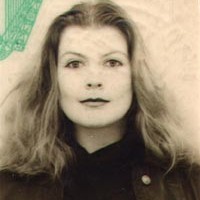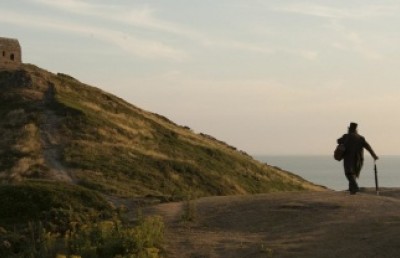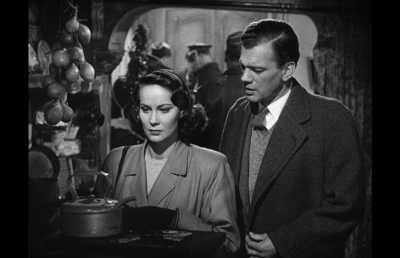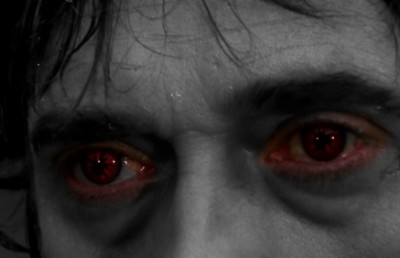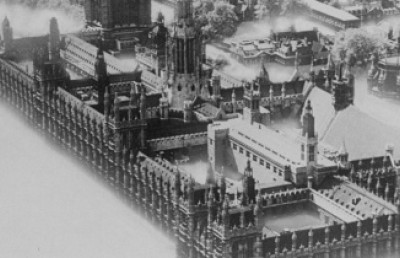The Trouble With Harry: The Third Man (1949), Part 2
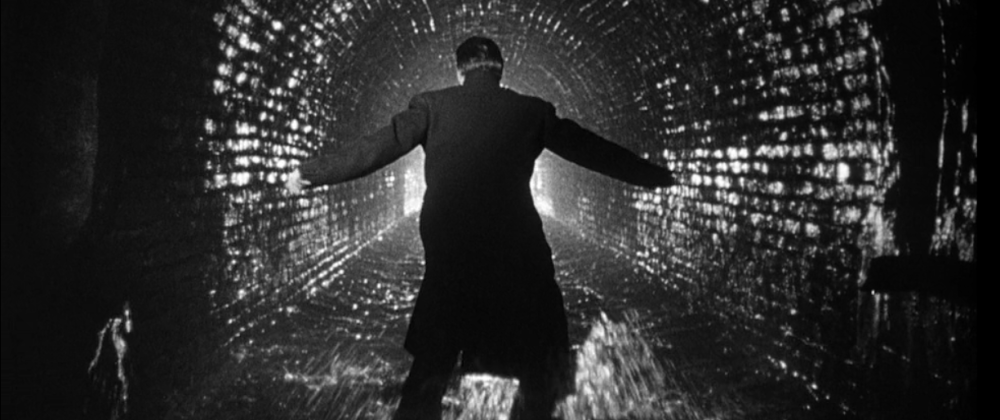
For Bonnie and Frodo
Omne trium perfectum
The film is called The Third Man and constantly reinforces the rule of three in its three-act construction. Greene was undoubtedly aware of the impact of triadic use and the rule of three has a major impact on the progressive effect of the dramatic components. There were three men at Harry’s supposed death, as Holly is eventually told. There are three characters whose names begin with H: Holly, Harry, Harbin. Baron Kurtz says he has acid, Harry needs antacid tablets from the States, and the kicker is his involvement in the city’s diluted penicillin racket: in Greene’s first draft script he has Calloway describe it as “working like a totalitarian party.” There are three visits to the city’s cemetery and Harry’s funerals bookend the narrative.
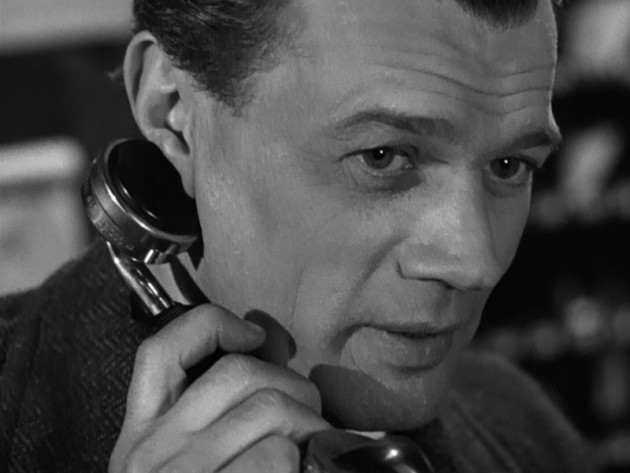
Holly
Theme
Lajos Egri formulated the classic approach to dramatic writing in which he states premise – or theme – as the central component of the successfully written play:
Every good play must have a well-formulated premise. There may be more than one way to phrase the premise, but, however it is phrased, the thought must be the same.
He urges the playwright:
You must have a premise – a premise which will lead you unmistakably to the goal your play hopes to reach (Egri, op.cit.: 6).
He also states: “In a well-constructed play or story, it is impossible to denote just where premise ends and story or character begins” (29). “Neither the premise nor any other part of a play has a separate life of its own. All must blend into an harmonious whole” (31). Greene’s work is consumed by issues of loyalty, betrayal and treachery: this deep structure underlies the film. Treachery is signified in each of Harry’s compadres but also in the horrifying manchild Hansel with the round face who wrongly accuses Holly of being a murderer – he is perhaps an allusion to Harry himself as he comes to be revealed in Orson Welles’ babyface or indeed a preview of coming attractions in Nicolas Roeg’s later Don’t Look Now (1973) as Paul Driver points out (1990: 38).
The man who knew too much
Philip Dunne writes, perhaps rather contentiously, in his memoir,
The director may contribute visual and technical style, but the essential style of any picture is in the delineation of character, in the building of conflict and drama, in what stimulates the viewer’s mind, not his eyes, and that is the contribution of the writer (Dunne, 244). 1
Undivided authorship is a rarity; the model for a truer understanding of filmmaking praxis is more likely to reside in models of multiple authorship. The value of auteurism in its original incarnation lay in its recognising of certain directors’ contributions to films; and in the elevating of Hollywood genres (Tudor, 1973: 122-3). Its essentialism as an interpretive text however denies its wider applicability: theory cannot prescribe practice, only describe it post hoc; and auteurism, as Dudley Andrew points out, may be experiencing a renaissance (Andrew in Stam and Miller, 2000: 20-30). Auteurist study retains its intrinsic value and relevance if it is applied to a wider variety of cinema practitioners, redressing the balance of film history through a more precise attribution of authorship and the evaluation of other cinematic signatures through the detailed examination of, as, for example, in this case, a single writer. Its great achievement was the evaluation of American cinema, still the world’s dominant narrative force. As Robin Wood points out, the search for a structure “can draw attention to some of the possible sources of a successful work’s vitality” (Wood, 2006: 248). By exploring “the thematic and formal relationships between ostensibly different projects of a single” [screenwriter], a consistent pattern can be observed which suggests a personal vision or controlling idea, the constituent elements denoting a cinematic author. By addressing the visual aspects of these same screenplays the project of auteurism is extended into a formal discourse which extends its relevance to film studies (Luhr and Lehman, 1977: 26). Wood also declares: “A work of art can transcend the personality, values, world-view of the artist; the greatness of a given film may be the product of an intricate interaction in which collaborators, circumstances of production, studio pressures, might all play their part (Wood: 248).
As Pam Cook avers, the concept of the auteur in British cinema has been immensely problematised by the specificity and infinite rearrangements pertaining to British film culture involving issues of critical taste, concepts of literary value and criteria attaching to value, all stressed and invigorated by debates within the journals Sequence, Sight & Sound and Movie (Cook, 1990: 147). Carol Reed’s career happened to precede the debate and endure during the 1940s and onwards while it was at its zenith, through the 1960s when his reputation proceeded to decline. Cook states:
Reed’s reputation as a distinguished metteur-en-scène seems to rest on the evidence of a few films from his total production and a few privileged moments in some films which can be seen to epitomise the ‘essence’ of his style: the concern with employing cinematic mise en scène to emphasise social and psychological conflict (Cook: 158).
In the late 1940s James Mason was considering a move to Hollywood; he thought that a fluke hit like The Seventh Veil (Bennett,1945) was rare. At that time in British cinema he says that as there were only six good directors, including Reed, and if each of them made a film, “that would be a very good year” (Mason, 1982: 206). In his memoir he states that Reed was his favourite director: “I had never worked with him but in every one of his films that I had seen there was great warmth and understanding… I had admired Carol Reed only from a distance. Though he was the director with whom of all directors in the world I was most keen to work” (Mason: 213-4).
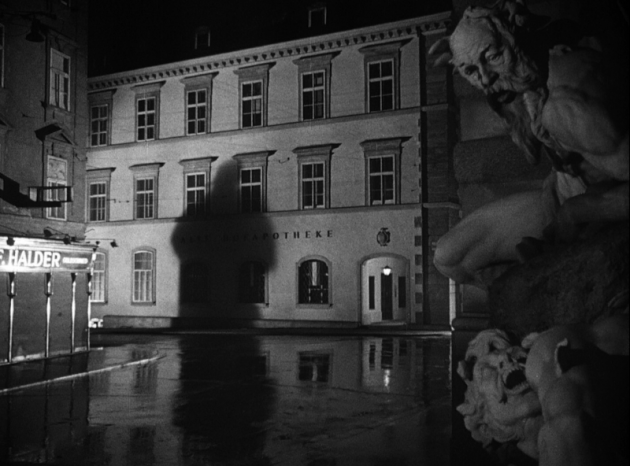
Expressionist heritage
According to his biographer, Reed believed himself to be the translator of authors’ stories. Cook argues that these collaborators contributed more to Reed’s position than his own work (Ibid.). And Drazin states: “for Reed the story was paramount. He could plumb the deepest depths of character, squeeze out every last drop of atmosphere and tension, but always he did so in service of the story” (Drazin, 2000: 85). However, as Nicholas Wapshott points out, “inevitably elements of Reed’s character do surface in his films, for he was not able to purge his own point of view entirely from his work, even though he had become used to disguising who he was for most of his life. The glimpses of Reed in his films are to be found among the many children who wander helpless and innocent through an adult’s world, and in the amoral heroes who suit themselves whatever distress they may cause to others” (Wapshott, 1990: 343). One obvious indicator is the direct quote from his previous film, The Girl in the News (1940) when a cat watches his mistress overdosing – something that would be effectively repeated in The Third Man. He quotes other films, too: Joseph Cotten’s entrance to Vienna on a train wreathed in smoke replays his arrival as murderous Uncle Charlie in Hitchcock’s Shadow of a Doubt (1943), itself a nod perhaps to Tolstoy; while his emergence from a shrouded tunnel after killing Harry provides not just closure on Holly’s quest for truth and vengeance but parlays a visual rhyme with the opening shot. The overall visual style, in particular the tilted shots, reflects the Expressionist choices he made for filming _Odd Man Out _ (1946), also DP’d by Robert Krasker, in another instance of a film concerned with moral equivocation in a city under occupation. James Mason observed of him that he “had the virtue of absolute unpretentiousness. He was unaffected by technical gimmickry… Other directors fall in love with their zoom lenses, extravagances of cutting or the dubious virtues of the hand-held camera. Carol Reed favoured a steady camera so that the spectator would be totally unaware both of camera movement and of cutting” (Mason: 217).
Dan O’Herlihy spoke to author Sheridan Morley:
… it was really Carol’s film: he knew exactly what he wanted each frame to look like and, apart from Robert Newton as the painter and Fay Compton as the woman who takes Mason into her home, he cast the whole picture locally in Belfast so it has this remarkable authenticity (Morley: 79-80).
Charles Drazin believes it is in that production that Reed “found his register. He found the things he could do well – an empathy with children, a feel for urban space, a sense of the unexpected” (Drazin, 2007: 66). He finds that Reed’s talent for orchestrating chance stood to the film, including casting extras off the street, filming on actual bomb sites and permitting Welles to improvise the famous cuckoo clock speech which is likely adapted from McNeill Whistler (68). The author concludes that “the brilliance of his best work lay not in putting forward a point of view, but in an intuitive feeling for the way people are and what they do. He was an observer.” He likens the director to an Old Master: “their art lay not in what they chose to paint but how” (70).
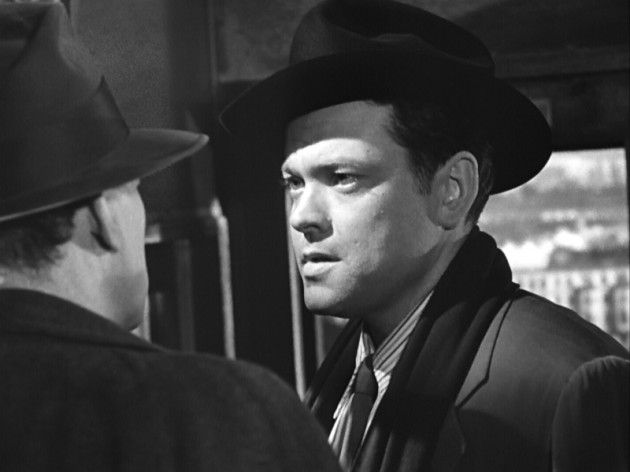
The strategic decision to film The Third Man primarily on location (one of the first British films to do so) lent itself to the neo-realistic style to which Reed was becoming aligned and placed it in a spectrum of politically-oriented films set in the occupied cities during the period in question (1945-1955). The abstraction of the zither’s strings in closeup in the title sequence hints at an avant garde inclination on the part of Reed but it also provides a template for the visuals’ focus on the city as a series of parallel lines which eventually cross metaphorically at various intersections, moral and storywise (Misek, 2007). The impossibility of the characters’ lives intersecting successfully is also wrought in this striking opening image. The acute off-centre angles utilised by Krasker accentuate Holly’s lack of knowledge and agency as well as disturbing our perception of what it is we think we are seeing. The complex visual design and shooting style obviates any prior knowledge of the city; the jump-cutting confuses our notion of space and perception and enhances our empathy with Harry’s situation as he is ultimately trapped by the film’s aesthetics. The moral order is ultimately restored, if temporarily, but with Harry’s death the price. Self-righteousness trumps loyalty. Ray Durgnat sums up the authorship of the film as follows: “Greene and Reed share one inspiring obsession: treachery – malevolent, or righteous, or inadvertent – is the human condition” (Durgnat in Murphy, ed., 2008 : 257). Overall, it could be stated that Reed’s complex relationship with contemporary film aesthetics is directly expressed in his choices for The Third Man. Paul Driver lists his props starting with the parrot, then the “ball, balloons, bunches of flowers, dog, cat, teddy bear and the numerous staircases” (Driver, 1989-90: 38).
Animals connote action too. Ever the master of concealment, Harry’s whereabouts are given away by the presence of a lovable kitten (“I just liked the idea of a cat loving a villain – the charm of the man!” declared Reed, quoted in Wapshott: 229); the miniature dog tells Holly that Kurtz is dining with Dr Winkel; while the analogy of Harry with a rat is the final indignity prior to his killing in his chosen escape route, the sewage system. This is similar to He Walked By Night (Werker/Mann, 1948) in which a psychotic murderer uses his knowledge of Los Angeles’ system to escape the police, until the final confrontation; and similarly gave a gifted Director of Photography (in this case, John Alton) ample opportunity to visually exploit the possibilities of chiaroscuro light and shade, deep focus, wide lenses and an overwhelming sense of entrapment. In yet another symmetrical incident and image which accretes the complexity of the film’s construction, the spiral staircase on which Harry is finally caught mirrors the apartment house stairwell, but now his fingers grasp pointlessly onto a Viennese square through a grating – there is no escape. And the wind whistles as though tumbleweed were about to blow through a western town, with voices echoing in the distance.
Sarris pinpoints Reed’s characteristic imprint in cinema: “Reed’s films are distinguished by the subtlety and variety of his directorial devices, and the integration and balance of those effects within a controlled frame. Reed is unique without being completely original or revolutionary. His genius is relative rather than absolute, relational rather than specific. Other directors are subtle and varied, also, but at this point in his career, Reed is more so” (Sarris, Oct 1957: 12). As Nicholas Wapshott points out, “it was Reed’s close involvement in all aspects of his films, from scriptwriting to set design, cutting and editing, which had caused him to hesitate about working in Hollywood” (Wapshott, 1990: 180). But the film would be a triumph despite the meddling by Selznick and the diva-like behaviour of Welles, who was under contract to Korda for three films.
Naming names
The naming of names is of paramount importance in The Third Man. Harry Lime connotes both Philby and Greene himself (his given name was Henry Graham), while Harry’s story has as we have seen many of the contours of Philby’s life in 1930s Vienna, including the circumstances of his marriage to a Communist in 1934; Holly obviously references the author and his movement between fact and fabulism, in a change to the treatment where the character is called Rollo. Calloway is a letter away from his real-life inspiration, Galloway, with all the dread that those first two syllables supply (in both cases); Anna is a slippery anagram that could be of any national origin yet calls to mind several heroines in Greene’s fiction; and Sergeant Paine’s destiny is writ large in his surname. Holly’s constant mispronouncing of people’s given names betrays his discomfort at his own ‘silly’ name, which he admits late in the narrative; while Anna’s repeated use of ‘Harry’ for ‘Holly’ suggests that he will in fact replace Harry Lime in her life, as Holly hopes, but it is not to be. She cannot tolerate his disloyalty to his childhood friend. Holly despises policemen and calls them only ‘sheriffs.’ He deliberately mispronounces Winkel’s name and repeatedly calls Calloway ‘Callaghan.’ The naming of things and people is crucial to our understanding of Vienna, the biggest character of all, a liminal space of bridges and slippery cobbled streets, locked off above and filled with traps below. Language is futile and the distance between people is directly expressed in their particular brand of logophobia. Words are simply inadequate to articulate the post-war condition.
A quest
Former Hollywood creative advisor Chris Vogler’s Hero’s Journey model as interpreted in The Writer’s Journey proved a popular text in the 1990s, not least among Hollywood’s development executives, but also among film and screenwriting students. It provides an accessible reading of Joseph Campbell’s take on Carl Jung through direct application to screenplay analysis. Providing a paradigmatic model for the practising screenwriter, Vogler discusses the major elements of Campbell’s The Hero With a Thousand Faces in terms of mainstream Hollywood cinema. The twelve-point template Vogler proposes is as follows and maps onto traditional dramatic structure thus:
Act One:
1. The hero lives in the Ordinary World (Holly is a broke writer)
2. The hero receives a Call to Adventure (Harry invited Holly to visit)
3. The hero Refuses the Call (Holly arrives too late)
4. The hero Meets his Mentor (Holly attends Harry’s supposed funeral)
5. The hero Crosses the Threshold,
Act Two:
6. and encounters Tests, Allies and Enemies.(Holly meets Harry’s friends)
7. He approaches the Inmost Cave, (Holly finds Harry alive)
8. where he endures the Supreme Ordeal. (Holly learns Harry isn’t straight)
9. The hero Seizes the Sword. (Holly defends Harry)
Act Three:
10. and journeys on the Road Back (Holly is finally persuaded of Harry’s ill-doings)
11. The hero experiences Resurrection (Holly delays his trip home and kills Harry)
12. and Returns with the Elixir (Holly is alive but fails to get Harry’s girl)
(Vogler, 1992: 236)
The classical structure of The Third Man maps, with a couple of twists, onto the format. Howard and Mabley remind us that “the protagonist and the obstacles he or she encounters must be fairly evenly matched… This point may be contradicted by such films as The Third Man … in which the element of a past action poses overwhelming odds against the achievement of the objective. It should be noted that the protagonists do no acknowledge the inevitability of failure until that failure stares them in the face and they must bow to it. They fight against the odds, believing they have a chance of succeeding; it is the character’s belief that keeps the story alive, that gives us the needed shred of hope that the goal might still be achieved” (Howard and Mabley, 48). Vogler’s impetus to write the book came from his experiences as a creative analyst at a major studio – Disney– when he decided to collate the lessons he had learned from world storytelling into a model for understanding screenplays. A memo to this effect, outlining his findings about the shape of popular stories, circulated in Hollywood and eventually mutated into the published book. By the time this had occurred, his tenure at Disney saw the studio return to top form with unprecedented box office grosses by creating traditionally structured fare —along the lines suggested by Vogler— such as The Little Mermaid and The Lion King. This structure can be easily mapped onto The Third Man, as above, and increasingly, global, film narratives – and not merely because Vogler is a regular on the global script lecturing circuit, frequently employed by state-sponsored media bodies. 2 This structure easily tells us Holly’s role in the narrative if not quite grasping the complexity of the friendship that underlies it.
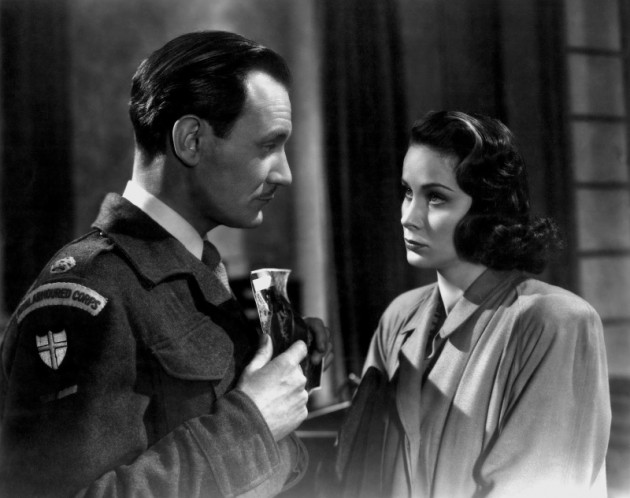
Calloway and Anna
Holly finds himself running after Harry’s shadow – and it promptly disappears from sight. He is alone in an empty square. He brings Calloway and Paine and they are momentarily puzzled – until Calloway reveals that the kiosk has a door and the stairwell leads into the city’s main sewer and onto the Danube. “We should have dug deeper than a grave,” he muses. And so they go to the cemetery a second time and open the coffin that was laid in Harry’s name and discover the corpse of Harbin. “Next time we’ll have a foolproof coffin,” promises Calloway. Back at Anna’s flat four military police arrive in a jeep to take her away because of ‘protocol.’ “I don’t even know what that means,” confesses the British member of the party. Holly rushes to her and cries out, “I’ve just seen a dead man walk. Now I’ve seen him alive.” Calloway asks her when she last saw Harry and she swears it was two weeks ago. He tells her about Harbin. “Vienna is a closed city, Ms Schmidt. He can’t get away.” “Poor Harry,” she says, “I wish he was dead. He would be safe from all of you then.” In daylight, Holly visits Kurtz and Winkel, the backdrop to the flat in the Russian sector is piles of rubble – and, crucially, the Prater Wheel, miraculously spared from bombing. He demands a meeting with Harry and waits by the wheel. “Or do ghosts only ride by night, Dr Winkel? Got an opinion on that?”
Located deep in the Russian sector, it is the perfect spot for Harry to reappear and create more mystery. Harry approaches Holly in a long shot, like a western character approaching a shootout. Holly admits telling the police. Harry doesn’t care about Anna’s predicament and Holly works out that it was he who handed her over. Holly tells him they opened his grave. Harry opens the door to the carriage and they have a conversation with implied threats of killing Holly. “The world doesn’t make heroes,” Harry tells Holly, “outside of your stories.” “You used to believe in God,” sighs Holly. Harry’s inflated opinion of himself aligns him with political leaders gazing down at the dots below the Prater Wheel with infinite contempt. They are not people to him.
He complains about the antacid tablets he needs from the States for his digestion and delivers his famous cuckoo clock speech, rushing off by the carousel. He has spent precisely five minutes stating his point of view.
Calloway instructs Holly to arrange to meet Harry in a café where he will be lifted. “Twenty years is a long time,” pleads Holly, “don’t ask me to tie the rope.” He sees Anna’s passport and cuts a deal for her release. At the railway station as Paine loads her luggage and she looks out of the railway carriage she espies Holly entering the café. She suspects he is meeting Harry and remains with him, mis-naming him ‘Harry’ once again. “Poor Harry,” she then says, about the real Harry, when she realises he is about to be caught. “You’ve got your precious honesty and don’t want anything else,” she chides Holly.”… I don’t want to see him, hear him,” she says when Holly realises she still wants Harry. “But he’s still part of me, that’s a fact, I couldn’t do a thing to harm him.” The train whistles. It’s a warning. “Look at yourself,” she tells him. “They have a name for faces like that.” Harry shows up and it looks as though he might kill Holly with his handgun but Anna warns him to run.
I think we are in rats’ alley where the dead men lost their bones
And then the descent into the underworld. Greene describes this in the novella:
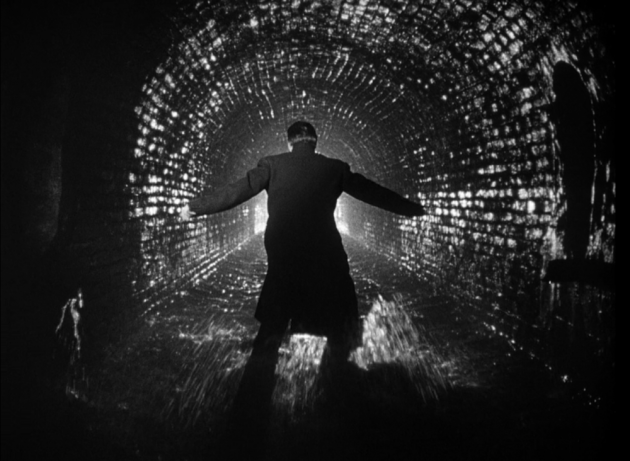
Lime trapped like a rat
What a strange world unknown to most of us lies under our feet: we live above a cavernous land of waterfalls and rushing rivers, where tides ebb and flow as in the world above. If you have ever read the adventures of Allan Quatermain and the account of his voyage along the underground river to the city of Milosis, you will be able to picture the scene of Lime’s last stand. The main sewer, half as wide as the Thames, rushes by under a huge arch, fed by tributary streams: these streams have fallen in waterfalls from higher levels and have been purified in their fall, so that only in these side channels is the air foul. The main stream smells sweet and fresh with a faint tang of ozone, and everywhere in the darkness is the sound of falling and rushing water (Greene, 1950: 314).
The film’s dénouement hinges on Holly’s decision – to stay or to go. In the end, en route to the airport, Major Calloway stops at the Children’s Hospital where Holly is shown the devastating effects of the diluted penicillin. We judge the obscenity of the ersatz medication by his facial reactions. One child’s death is signalled by the upturning of their Teddy bear. Holly stays – he knows he is the lure for Harry’s death. He takes action, goaded into to it by Galloway’s fatal bargain. Their pas de deux exploits Calloway’s recognition of Holly’s capacity for jeopardy and betrayal. This is the dramatically logical outcome to Holly’s visit to Vienna and the outcome of his quest. He is the only person who can kill Harry, who is now his nemesis when his sense of justice is outraged at Calloway’s heavy-handed suggestion and he knows Harry has sold out Anna. In order to achieve this, he has to overcome his own distaste for playing at sheriff. This is the point of no return in the narrative. Paine has loaned his copy of The Oklahoma Kid to Calloway, therefore the action is spun into another phase. Holly is sheriff.
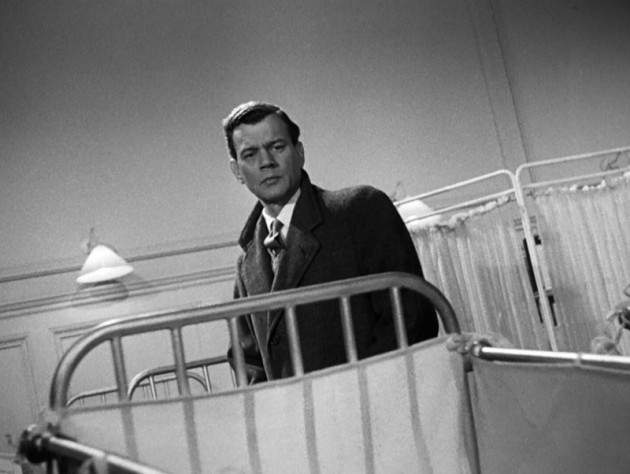
The exciting chase sequence commencing in the rubble where Harry has been watching his watchers and proceeding along the streets where he is pursued by troops and the sound of sirens underground into the sewer, is masterfully staged and executed. Due to interference by censors a line had to be added to Calloway’s dialogue giving Holly permission to shoot. When a figure emerges, wreathed in smoke at the end of the tunnel, we are unsure who has survived the encounter. The film cuts to a funeral, where Holly once again stands beside Calloway and we know this is perfectly symmetrically constructed, with the really Harry Lime finally put in a grave. Holly has ratted on his friend, in this tale of ever-changing parallels and symmetries. Anna throws dirt on the coffin – which she did not do at the fake funeral, suggesting perhaps she always knew Harry was still alive. Then she walks away, as before. However Holly alters his behaviour this time and asks to be let out of the jeep to talk to her but she walks by him. The construction of the film is therefore a symmetry that does not merge with convergent destinies: Anna’s rebuffing of Holly demonstrates that the past is just that, and does not mean there is an alternate future. She refuses pity or a form of colonising and presumably carries on with acting, her profession. She has been acting all along, after all. As Charles Drazin points out, it was Selznick’s suggestion to have this be the film’s ending. Greene’s happy ever after just did not ring true (Drazin,1999: 23). Holly’s attempt to rewrite Anna’s life as he has done his own (and Harry’s) has just brought tragedy to her door. His redemption has come through the use of controlled violence. It has overcome his friendship. The creator of hack fiction has become the destroyer of a real man. The sediment of passion which underlies his actions is not reciprocated.
According to Carpenter, Greene never confused personality with morality (Carpenter, 1987: 63) therefore the issue of Holly’s loyalty to Harry does not transgress the theme of the story. Harry is so charismatic that he overwhelms Holly and as Joseph McBride states, “the lasting appeal of dark, complex characters, whether they are villains or antiheroes or deeply troubled heroes, demonstrates that the virtue of ‘likability’ is largely confined to real life, not dramatic storytelling” (McBride, 2012: 49). “One can’t just leave,” protests Calloway to Holly, half-heartedly as they exit the cemetery following the second, real funeral for Harry Lime. “Be sensible.” “Haven’t got a sensible name, Calloway,” says Holly. Calloway watches as Anna walks past him.
A grave literary enquiry
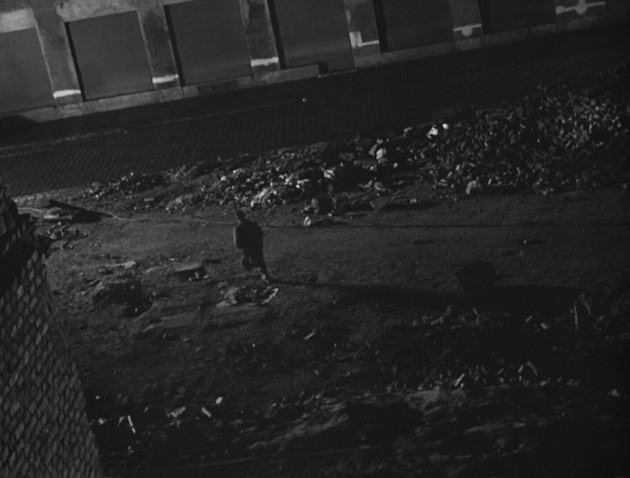
The Chase
The dissolution of order leaves us bereft. The arc of the story is not altered but it is dramatically logical and unfolds with a shootout as the generic impetus suggested by Holly’s novels always directed us to expect. Holly’s quest for truth has become one of vengeance, like the typical western hero of his pulp novels. No longer an outside observer but a participant whose decision to act leaves devastating consequences but also a supposed restorative justice, we are left to ponder in a Thomsonian way what kind of books Holly might attempt in the aftermath of human tragedy. No longer a neutral, loyal friend or hapless drunken tourist, he has become what he most reviled. His westerns might have obtained the kind of psychological component developed after World War 2 in their cinematic iteration, in which a more cautionary attitude to violence and venality coloured the depiction of gunslinging, territorial acquisition and conquest and the genre became mature and self-questioning. The Third Man is balanced precariously between opposing lines of thinking, border controls and symmetries, in a system of binary structural oppositions that culminates in the restitution of order after the chaos of one man’s playing the post-war system in an occupied city filled with petty fiefdoms battling for control. The ending was changed from Greene’s novella, and he stated that it was better because the original, in Reed’s view, would have been too cynical. Freighted with history, Anna takes a long walk toward and past the camera in bleached daylight, leaving the ever-hapless Holly in her wake. The film’s final shot, achieved with some practical difficulties on the day, peels away the pretence of friendship or goodness or decency. Anna’s integrity is intact. Holly is bereft: a traitor and a killer, he has not managed to steal Harry’s lover or change the world or do anything worth mentioning. He just killed his best friend —even if it were to be interpreted as a mercy killing and on military orders. He chased Harry’s shadow and discovered his own. The desolation is wrenching.
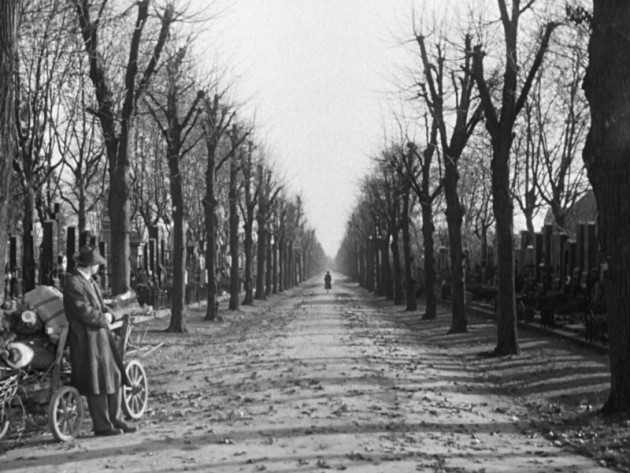
Final Scene….what a shot
A moral vision
Principal photography was completed 31 March 1949 and the film was released in the United Kingdom 03 September 1949 and 06 January 1950 in the United States. There was a slight difference in the text of the opening voiceovers (and while the American release was voiced by Joseph Cotten, the British one was performed by Reed). It was a huge success and Anton Karas’ theme music was a hit. The film won the Grand Prix at Cannes and Robert Krasker received the Academy Award for best black and white cinematography (Reed was nominated for directing and Oswald Hafenrichter for editing). It won the BAFTA for Best British Film and the National Board of Review award for Best Foreign Film. It would remain a huge audience and critical favourite as the lists of Best British Films attest over the intervening years. 3
Robin Wood points out that the search for a structure “can draw attention to some of the possible sources of a successful work’s vitality” (Wood, 2006: 248). By exploring “the thematic and formal relationships between ostensibly different projects of a single” [screenwriter], a consistent pattern can be observed which suggests a personal vision or controlling idea, the constituent elements denoting a cinematic author. By addressing the visual aspects of these same screenplays the project of auteurism is extended into a formal discourse which extends its relevance to film studies (Luhr and Lehman, 1977: 26). Greene’s world of subterfuge and conflicting loyalties was balanced by Reed’s humanity in this interpellation of memory, history and genre. Brian MacFarlane describes the pairing of director and writer: “Reed’s and Greene’s creative personalities chimed perfectly in their two 40s films: both films are studies in disillusionment and the melancholy of innocence brought face to face with corruption” (MacFarlane in Barr, 1986: 133). Whatever local objections existed to the production and its release, as Thomson argues, “a time and a place were captured; scenario and locale were stirred, like cream going into dark coffee” (Thomson, 1994: 621-2).
In fiction, he is tart but refreshing. Whereas, in life, he was poison (Thomson, 1985: 102).
For a protagonist’s plight to be fully communicated it is essential that he have a worthy antagonist. Harry Lime is all that, living on in the imagination long after Holly Martins’ delusional treachery is forgotten. In this film, Greene found a way to transmogrify fact into fiction, with a heart, a soul and a conscience. Reed consolidated the internal dilemmas with wonderfully significant external reality. Greene was grateful to Reed and wrote of him that he was “ ‘the only director I know with that particular warmth of human sympathy, the extraordinary feeling for the right face for the right part, the exactitude of cutting, and not least important the power of sympathizing with the author’s worries and an ability to guide him’” (Drazin, 2007: 68). Harry Lime would have an afterlife, in a radio series produced by Harry Alan Towers that was designed as a prequel to the film and was played (and to an extent written) again by Welles, but, as Matthew Killmeier puts it, sweetened for the internationally syndicated domestic palate (Killmeier: 1). It commenced with a gunshot and a voiceover by Harry himself explaining his resurrection from the sewer, no longer a victim of an aesthetic based on entrapment. It gave rise to the feature film Mr. Arkadin (also known as Confidential Report) (Welles,1955) which was adapted from the 37th episode, ‘Man of Mystery’, with a Citizen Kane-type screenplay by Welles. Critic Jonathan Rosenbaum has identified seven different versions of the film, complicating further Welles’ contribution to the authorship of the character Harry Lime (Rosenbaum, 2007: 146-162). In David Thomson’s universe of Suspects, Lime is resurrected as a magazine character and TV star by Martins in order for him to prolong his own career as fiction-maker. In fact there actually was a Third Man TV show, which ran for five seasons, starting in 1959 and it was based on stories published in The News of the World.
Thomson imagines Holly to have been Harry’s ‘pet crony’ and the Juliet to his Romeo, in Dulwich College, alma mater of Raymond Chandler, whose lead he follows in this hallucination of noir. Harry’s career also mirrors Philby’s in his forming the International Refugee Office which grants him a cover for his rackets. So his legend lives on, as that of a notoriously sympathetic villain, in our collective psyche. Holly is just a user and the most demonic of bad friends. As T.S. Eliot once wrote, “Humankind cannot bear very much reality.”
He had all the small loyalties to his colleagues, and of course his big loyalty was unknown to us (Greene in Philby, 1979: 9).
For Greene, friendship trumped everything and he remained loyal to Philby even after he was named as the third man by the newspapers following his being cleared by Harold MacMillan and his subsequent defection to the Soviet Union. Suspicions about Greene’s supposedly dubious political sympathies followed him to the grave.
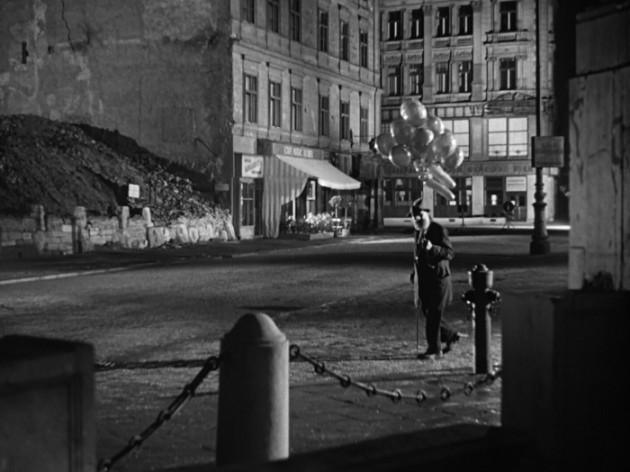
Homage to Lang’s M?
Reed and Greene brought out the best in each other and their three films remained some of Reed’s greatest achievements against the backdrop of a permanently faltering British film industry. “It is true that Carol Reed never made another film that matched up to Odd Man Out or The Fallen Idol or The Third Man. But the fact that they had been made was enough. They came about in an extraordinary decade through a conjunction of circumstances that could not be repeated, and it was in Reed’s nature to want to move on” (Drazin, 2007: 69). Together they crafted a story about storytelling, a plausible fiction and a pleasurable piece of propaganda. Perhaps it is ultimately Reed’s film: he changed the ending, his visuals impute the spy genre with the motifs and concerns of the Trümmerfilm and it was his narrative preoccupations that aped an earlier film The Mask of Dimitrios (Negulesco, 1944), adapted by Frank Gruber from the eponymous Eric Ambler novel.
The film still plays in Vienna at the Burg-Kino a few times a week. The rich resonance of its tapestry lies in its origins in the vagaries of writing and rewriting, truth and fiction, roleplaying and performance. Finally, myth is balanced by countermyth, the hero gains a motive and becomes a villain, the creature he most reviles –the newest sheriff in town, in a town of too many such creatures playing loyal to too many paymasters with conflicting agendas. The bigger villain, Lime, is one of the most likable men we have ever encountered. The Third Man is ultimately a grave literary inquiry into our behaviour: it poses and answers the question as to why we tell stories to ourselves – to make sense of things, to make things better, to reconcile inertia with action in the face of supposed evil, to have our loyalties tested, to change the world, little by little. The rest is meaningless.
End of Part 2
(Essay submitted in 2013)
Thank you to Dr Claus Tieber at the University of Wien and to staff at the British and Irish Film Institutes for assistance in sourcing materials.
Bibliography
BooksAristotle (1920). On the Art of Poetry. Oxford: Oxford University Press.
Barr, Charles (ed.) (1986). All Our Yesterdays: 90 Years of British Cinema. London: BFI.
Bazin, André (1978). Orson Welles: A Critical View. London: Elm Tree Books.
Behlmer, Rudy (1972). A Memo From David O. Selznick. New York: Viking.
Bogdanovich, Peter (1998). This Is Orson Welles. New York: Da Capo.
Bordwell, David, Janet Staiger and Kristin Thompson (1994). The Classical Hollywood Cinema: Film Style and Mode of Production to 1960. London: Routledge.
Cook, Pam (1990). The Cinema Book. London: BFI.
Copjec, Joan (ed.) (1993). Shades of Noir. London: Verso.
Drazin, Charles (2000). In Search of The Third Man. London: Methuen.
________ (2007). The Finest Years: British Cinema of the 1940s (Cinema and Society). London: I.B. Tauris.
Dunne, Philip (1992). Take Two: A Life in Movies and Politics. New York: Limelight Editions.
Dyer, Richard (1998). Stars. London: BFI.
Egri, Lajos (1946; rpt.,1960) The Art of Dramatic Writing: Its Basis in the Creative Interpretation of Human Motives. New York: Touchstone Books.
Enzensberger, Hans Magnus (ed.) (1990). Europa in Ruinen: Augenzeugenberichte aus den Jahren 1944-48. Frankfurt am Main: Eichhorn
Fay, Jennifer and Justus Nieland (2010). Film Noir: Hard-Boiled Modernity and the Cultures of Globalization. London and New York: Routledge.
Glancy, H. Mark (1999). When Hollywood Loved Britain: The Hollywood British Film 1939-1945. Manchester: University Press.
Greene, Graham (1939/2001). The Confidential Agent: An Entertainment. London: Vintage Classics.
________ (1943/2001). The Ministry of Fear: An Entertainment.. London: Vintage Classics.
________ (1932 /2004). Stamboul Train. London: Vintage Classics.
________ (1950/1993). The Third Man in Brighton Rock. The Third Man. The Power and the Glory. The Heart of the Matter. 3rd reprint. London/New York: BCA.
Higham, Charles (1994). Merchant of Dreams: Louis B. Mayer, MGM and the Secret Hollywood. London: Pan Books.
Hoare, John (2000). The Third Man. London: York Press.
Horton, Andrew (ed.) (2004). Screenwriting for a Global Market: Selling Your Scripts from Hollywood to Hong Kong. Berkeley and Los Angeles: University of California Press.
Howard, David (2004). How To Build a Great Screenplay. A Master Class in Storytelling for Film. New York: St Martin’s Press.
________ and Edward Mabley (1993). The Tools of Screenwriting: A Writer’s Guide to the Craft and Elements of a Screenplay. New York: St Martin’s Griffin.
Kemp, Philip and Sir Christopher Frayling (2011). Cinema: The Whole Story. London: Thames & Hudson.
Langford, Barry (2005). Film Genre: Hollywood and Beyond. Edinburgh: Edinburgh University Press.
Korda, Michael (1980). Charmed Lives. Harmonsworth: Penguin Books.
Lawson, John Howard (1949). Theory and Technique of Playwriting and Screenwriting. New York: Putnam.
Lopate, Philip, ed. (2006). American Movie Critics: An Anthology From The Silents Until Now. New York: Library of America.
Luhr, William and Peter Lehman (1977). Authorship and Narrative in the Cinema: Issues in Contemporary Aesthetics and Criticism. New York: GP Putnam’s Sons.
McBride, Joseph (1972). Orson Welles. New York: Viking.
________ (2012). Writing in Pictures: Screenwriting Made (Mostly) Painless. New York: Vintage Books.
Mason, James (1982). Before I Forget. London: Sphere Books.
Morley, Sheridan (1990). James Mason: Odd Man Out. London: Coronet Books.
Murphy, Robert (ed.) (2001). The British Cinema Book 2nd edition. London: BFI.
________ (ed.) (2009). The British Cinema Book 3rd edition. London: BFI/Palgrave Macmillan.
Nowell-Smith, Geoffrey et al. (1996). The Companion to Italian Cinema. London: British Film Institute.
Palmer, Linda (1998). How To Write It, How To Sell It: Everything a Screenwriter Needs to Know About Hollywood. New York: St Martin’s Griffin.
Philby, Kim (1979). My Silent War: The Autobiography of Kim Philby. London: Granada Publishing.
Richards, Jeffrey (1997). Films and British National Identity: From Dickens to Dad’s Army (Studies in British Popular Culture). Manchester: Manchester University Press.
Ricoeur, Paul (1990). Time and Narrative Volume 1. Chicago: University of Chicago Press.
________ and David Pellauer (1995). Figuring the Sacred: Religion, Narrative and the Imagination. Minneapolis: Augsburg Fortress.
Rosenbaum, Jonathan (2007). Discovering Orson Welles. Berkeley and Los Angeles: University of California Press.
Russell Taylor, John (ed.) (1980). The Pleasure Dome: Graham Greene, The Collected Film Criticism 1935-40. Oxford: Oxford University Press.
Seger, Linda (1992). The Art of Adaptation: Turning Fact and Fiction into Film. How to Transform Novels, Plays, and True-Life Stories into Screenplays. New York: Owl Books
Shaw, Tony (2006). British Cinema and the Cold War: The State, Propaganda and Consensus (Cinema and Society.). London: I.B. Tauris.
Stam, Robert and Toby Miller (eds.) (2000). Film and Theory: An Anthology. Oxford: Blackwell Publishers.
Street, Sarah (1997). British National Cinema. London: Routledge.
Swann, Paul (1987). The Hollywood Feature Film in Post-War Britain. London: Croom Helm.
Taylor, John Russell (ed.) (1980). The Pleasure Dome: Graham Greene, The Collected Film Criticism 1935-40. Oxford: Oxford University Press.
Thomson, David (1985). Suspects. London: Picador.
________ (1994). A Biographical Dictionary of Film. London: Secker & Warburg.
Tierno, Michael (2002). Aristotle’s Poetics for Screenwriters. New York: Hyperion Books.
Timmermann, Brigitte and Frederick Baker (2002/2005). Der Dritte Mann: Auf den Spuren eines Filmklassikers/The Third Man’s Vienna. Vienna: Czernin Verlag/London: Shippen Rock Publishing.
Tudor, Andrew (1973). Theories of Film. London: Secker & Warburg.
Vincendeau, Ginette (1998). Pepé Le Moko. London: British Film Institute, 1998.
Vocelka, Karl (1985). Trümmerjahre Wien 1945-1949. Vienna: Jugend und Volk.
Vogler, Chris (1992). The Writer’s Journey: Mythic Structure for Storytellers & Screenwriters. Los Angeles: Michael Wiese Productions.
Wagnleitner, Reinhold (1994). Coca-Colonization and the Cold War: The Cultural Mission of the United States in Austria after the Second World War. Chapel Hill & London.
Wapshott, Nicholas (1990). The Man Between: Biography of Carol Reed. London: Chatto & Windus.
Welles, Orson and Others (1952). The Lives of Harry Lime. Norwich: Jarrold and Sons.
White, Rob (2003). The Third Man (BFI Classics). London: BFI Publishing.
Wood, Robin (2006). Personal Views: Explorations in Film (Revised Edition). Detroit, Michigan: Wayne State University Press.
Journals, Essays & ArticlesAndrew, Dudley, ‘The Unauthorized Author Today,’ in Stam and Miller, 2000: 20-30.
Annunziata, Lucia (2010), ‘A View from Abroad,’ The Guardian, 23 April 2010.
Berg, Charles Ramirez. ‘The Third Man’s Third Man: David O.Selznick’s Contribution to The Third Man,’ Library Chronicle of the University of Texas no. 38, 1986: 93-113.
Carpenter, L. (1987). ‘“I never knew the old Vienna”: Cold War Politics and The Third Man,’ Film Criticism, 11, 1-2: 56-65.
Cook, William. ‘The Third Man’s View of Vienna,’ The Guardian, Friday 08 December 2006, https://www.theguardian.com/film/2006/dec/08/3. Accessed 18 September 2013.
Driver, Paul. ‘A Third Man Cento,’ Sight and Sound Vol. 59 No. 1 Winter 1989-90: 36-41.
Durgnat, Raymond. ‘Some Lines of Enquiry into Post-war British Crime,’ in Murphy, 2001: 135-46 and 2009: 247-258.
Evans, Harold. ‘A duty to scrutinise.’ The Guardian 21 October 2013: 26.
Gomez, Joseph A. ‘The Third Man: Capturing the Visual Essence of Literary Conception,’ in Literature/Film Quarterly 2/4 (Autumn 1974):334-340.
Killmeier, Matthew ‘America(n) Abroad: The Third Man, International Audiences and the Cold War,’ To Download Paper: http://www.academia.edu/447433/America_n_Abroad_The_Third_Man_International_Audiences_and_the_Cold_War
MacFarlane, Brian (1986). ‘A Literary Cinema? British Films and British Novels,’ in Barr,1986: 120-142.
Misek, Richard (2007). ‘Wrong Geometries in The Third Man,’ Rouge. Accessed 09 Sept 2013.
Murphy, Robert (1986). ‘Riff-Raff: British Cinema and the Underworld,’ in Barr, 1986: 286-305.
Palmer, J.W. and Michael M. Riley, ‘The Lone Rider in Vienna: Myth and Meaning in The Third Man,’ Literature/Film Quarterly 8, 1 (1980): 14-21.
Petley, Julian (1986). ‘The Lost Continent,’ in Barr, 1986: 98-119.
Raskin, Richard (2001). ‘European Versus American Storytelling: The Case of The Third Man,’ POV Issue 12, December 2001. http://pov.imv.au.dk/Issue_12/section_1/artc8A.html Accessed 20 Sept 2013.
Rosenbaum, Jonathan. ‘Welles in the Lime Light: The Third Man’ www.chireader.com/movies/archives/1999/0799/070309.html
Sarris, Andrew. ‘First of the Realists: An Analysis of Carol Reed’s Work for the Cinema,’ Films and Filming, September 1957: 9-10, 32.
________ . ‘The Stylist Goes to Hollywood: An Analysis of Carol Reed’s Work for the Cinema (Part II),’ Films and Filming, October 1957:11-12, 30.
Schickel, Richard ‘Blue Velvet,’ review reprinted in Philip Lopate, (ed.) (1995). Originally published in Flesh and Blood: The National Society of Film Critics on Sex, violence, and Censorship. Ed. Peter Keogh. San Francisco: Mercury House.
Sinowitz, Michael. ‘Graham Greene’s and Carol Reed’s The Third Man: When a Cowboy Comes to Vienna,’ in MFS Modern Fiction Studies, Vol. 52, No. 3, Fall 2007: 405-433.
Van Wert, William F. (1974). ‘Narrative Structure in The Third Man,’ Literature/Film Quarterly Fall 1974, Vol.2, No. 4: 341-346. Accessed 20 Sept 2013.
Wollen, Peter. ‘Riff-raff realism,’ Sight and Sound, Vol. 8, no. 4 (NS), April 1998: 18-22.
_______. ‘The Vienna Project,’ Sight and Sound, Vol. 9, no. 7 (NS), July 1999: 16-19.
Online sourcesGreene, Graham (1948) The Third Man screenplay, undated, www.dailyscript.com/sccripts/the_third_man.html
“The Third Man: Vienna in the Footsteps of a Film Classic-An Hommage” www.thethirdman.net/pages/derdrittemann.html
“When Harry Lime met Mr. Arkadin: ORSON WELLES script for “Man of Mystery” http://www.wellesnet.com/when-harry-lime-met-mr-arkadin-orson-welles-script-for-man-of-mystery/
OtherVienna – The Shadow of the Third Man BBC Radio 4 TX: 02 June 2009
FilmographyArena: The Orson Welles Story (1982) BBC Television.
Cinefile: Dark and Deadly Film Noir (1995) d. Paul Joyce. Channel Four Productions.
Dangerous Edge: A Life of Graham Greene (2012) O’Connor Films, LLC
The Fallen Idol (1948) d. Carol Reed, s. Graham Greene and Lesley Storm (additional dialogue) and William Templeton (additional dialogue)
Odd Man Out (1947) d. Carol Reed, s. F.L. Green and R.C. Sherriff.
In the Shadow of the Third Man (2004) d. Frederick Baker, BBC Television
The Third Man (1949) d. Carol Reed, s. Graham Greene, Orson Welles (uncredited), Alexander Korda (story) (uncredited), Carol Reed (uncredited)
For a map of partitioned Vienna, see Dr. Timmerman’s http://mitteleuropa.x10.mx/filmlocations_the_third_man.html.
Notes
- Dunne further describes the differences between his screenplay for How Green Was My Valley (Ford, 1941) and a BBC TV version, commenting, “Perhaps their vision was truer than mine; I simply don’t know. I only know that their production was almost completely different, and the difference lay not in the direction but in the writing. It is a point worth remembering the next time you see that obnoxious credit ‘a film by’ some director, or some critic gives sole praise to an ‘Auteur’ whose principal contribution to the structure of a picture may have been merely deciding where to place the camera.” (244-245) Earlier in his memoir, on the subject of the same film, he declares that “the entire premise of the [Auteur] theory is false.” ↩
- See Ken Dancyger’s Global Scriptwriting for an account of the influence Hollywood’s screenwriting pedagogues are having on the commercial potential of international filmmaking in the English-speaking world and beyond. Boston, Mass: Focal Press, 2001. This is also covered in Horton, 2004. ↩
- Durgnat states of the film: “What gives it popular classic status is its atmosphere: a chemistry of realistic locations + slanting shadow-throws + deeply diagonal night-streets + Dutch tilts (learned from Duvivier) + strong, insolent, secretive faces + charged acting + zithery-slithery vibrations tangling and unwinding our nerves, teasing and haunting us like a ghostly hurdy-gurdy, in the key of Kurt Weill. It’s another meditation on the ‘iron law’ of betrayal (in Murphy, 2001: 144). ↩

